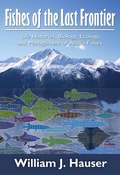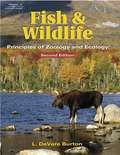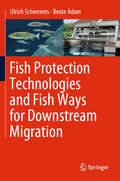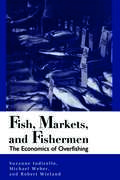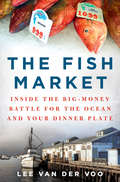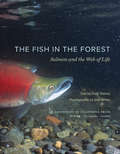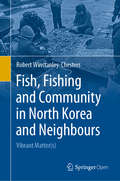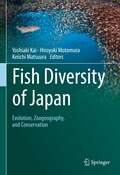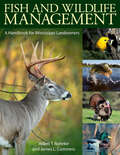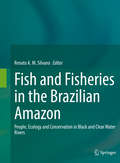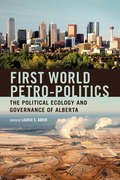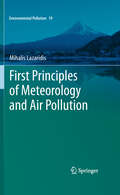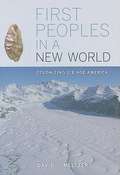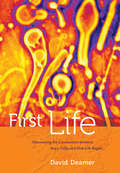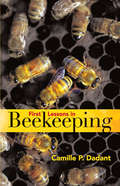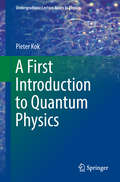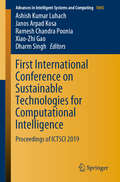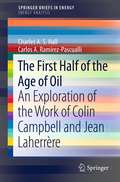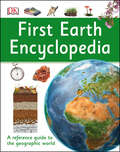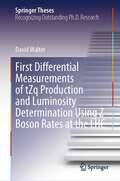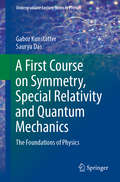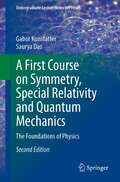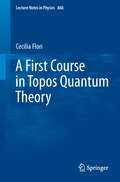- Table View
- List View
Fishes of the Last Frontier: Life Histories, Biology, Ecology, and Management of Alaska's Fishes
by Bill HauserFishes of the Last Frontier answers many of your fish questions and others you haven't even thought of yet in a nontechnical, plain talk voice. Learn about the fishes that are of value or special interest to Alaskans: how fish are able to survive and grow, how they get along with each other--or not--and what they eat, where and how our Alaska fishes spawn, the difference between a red and a redd, and the difference between anadromous and catadromous and why that is important. The author, a fishery scientist with nearly 50 years of experience and training, including more than 30 years in Alaska, describes the life history characteristics of 43 species of fishes valuable or important in some way to Alaskans. He delves into various aspects of biology and ecology of fish and provides insight into how humans and fish interact. The processes of fishery management in Alaska are described. Fishes of the Last Frontier includes fishes from throughout Alaska in fresh, brackish, and marine waters and sport, commercial, and subsistence fisheries. Learn not just how anadromous fish find their way home but also how scientists were able to learn the details. Nontechnical readers have reported the presentations as enjoyable, understandable, and informative.
Fish & Wildlife: Principles of Zoology and Ecology (Second edition)
by L. Devere BurtonThe book integrates the principles of zoology and ecology with the lives of different kinds of wild animals that inhabit North America and enlightens readers to the principles of biology in the context of how science relates to the survival of fish and wildlife. It gives descriptions of the lives, structures, growth, and classification of species in their natural habitats, and raises critical thinking questions to initiate the steps taken in the process of scientific discovery.
Fish Protection Technologies and Fish Ways for Downstream Migration
by Ulrich Schwevers Beate AdamThis book offers a comprehensive review of current systems for fish protection and downstream migration. It offers the first systematic description of the currently available technologies for fish protection at hydropower intakes, including accurate and timely data collected by the authors and other researchers. It describes how to design and test them in agreement with the guidelines established from the EU Water Framework Directive. The book includes important information about fish biology, with a special focus on swimming and migration mechanisms. It offers a robust bridge between concepts in applied ecology and civil hydraulic engineering, thus providing biologists and hydraulic engineers with an authoritative reference guide to both the theory and practice of fish protection. It is also of interest for planners, public authorities as well as environmental consultants
Fish, Markets, and Fishermen: The Economics Of Overfishing
by Michael L. Weber Suzanne Iudicello Robert WielandA significant number of the world's ocean fisheries are depleted, and some have collapsed, from overfishing. Although many of the same fishermen who are causing these declines stand to suffer the most from them, they continue to overfish. Why is this happening? What can be done to solve the problem.The authors of Fish, Markets, and Fishermen argue that the reasons are primarily economic, and that overfishing is an inevitable consequence of the current sets of incentives facing ocean fishermen. This volume illuminates these incentives as they operate both in the aggregate and at the level of day-to-day decision-making by vessel skippers. The authors provide a primer on fish population biology and the economics of fisheries under various access regimes, and use that information in analyzing policies for managing fisheries. The book: provides a concise statistical overview of the world's fisheries documents the decline of fisheries worldwide gives the reader a clear understanding of the economics and population biology of fish examines the management issues associated with regulating fisheries offers case studies of fisheries under different management regimes examines and compares the consequences of various regimes and considers the implications for policy makingThe decline of the world's ocean fisheries is of enormous worldwide significance, from both economic and environmental perspectives. This book clearly explains for the nonspecialist the complicated problem of overfishing. It represents a basic resource for fishery managers and others-fishers, policymakers, conservationists, the fish consuming public, students, and researchers-concerned with the dynamics of fisheries and their sustenance.
The Fish Market: Inside the Big-Money Battle for the Ocean and Your Dinner Plate
by Lee van der VooGulf Wild -- the first seafood brand in America to trace each fish from the sea to the table -- emerged after grouper, the star of fried fish sandwiches, fell off menus due to overfishing. The brand was born when the government privatized the rights to fish to fix the problem. Through traceability, Gulf Wild has met burgeoning consumer demand for domestic, sustainable seafood, selling in boutique grocers and catapulting grouper from the hamburger bun to the white tablecloth. But the property rights that saved grouper also shifted control of the fish from public to private, forever changing the relationship between wild seafood and the people that eat it. Aboard fishing vessels from Alaska to Maine, inside restaurants of top chefs, and from the halls of Congress, in The Fish Market, journalist Lee van der Voo tells the story of the people and places left behind in this era of ocean privatization--a trend that now controls more than half of American seafood. Following seafood money from U.S. docks to Wall Street, she explains the methods that investors, equity firms, and seafood landlords have used to capture the upside of the sustainable seafood movement, and why many people believe in them. She also goes behind the scenes of the Slow Fish movement--among holdouts against privatization of the sea-- to show why they argue consumers don't have to buy sustainability from Wall Street, or choose between the environment and their fisherman.
The Fish in the Forest
by Dale StokesThe Fish in the Forest is an elegantly written, beautifully illustrated exploration of the complex web of relationships between the salmon of the Pacific Northwest and the surrounding ecosystem. Dale Stokes shows how nearly all aspects of this fragile ecosystem--from streambeds to treetops, from sea urchins to orcas to bears, from rain forests to kelp forests--are intimately linked with the biology of the Pacific salmon. Illustrated with 70 stunning color photographs by Doc White, The Fish in the Forest demonstrates how the cycling of nutrients between the ocean and the land, mediated by the life and death of the salmon, is not only key to understanding the landscape of the north Pacific coast, but is also a powerful metaphor for all of life on earth.
Fish, Fishing and Community in North Korea and Neighbours: Vibrant Matter(s)
by Robert Winstanley-ChestersThis open access book explores the histories and geographies of fishing in North Korea and the surrounding nations. With the ideological and environmental history of North Korea in mind, the book examines the complex interactions between local communities, fish themselves, wider ecosystems and the politics of Pyongyang through the lens of critical geography, fisheries statistics and management science as well as North Korean and more generally Korean and East Asian studies. There is increasing global interest in North Korea, its politics, people and landscapes, and as such, this book describes encounters with North Korean fishing communities, as well as unusual moments in the field in the People’s Republic of China, the Russian Federation and the Republic of Korea (South Korea). It addresses fish, fishing infrastructure, fishing science and fishing statistics and other non-human elements of North Korean and other nations’ developmental regimes as actors and participants within them as much as humans and their technologies. The book enables readers to gain extensive insights into the aspirations and practices of fishing in North Korea and its neighbours, the navigation of difficult political and developmental situations and changing ecological realities in a time of environmental and climate crisis familiar to many across the globe.
Fish Diversity of Japan: Evolution, Zoogeography, and Conservation
by Yoshiaki Kai Hiroyuki Motomura Keiichi MatsuuraThis book reviews and summarizes the studies on the fish diversity of Japan. It covers the present knowledge of ichthyofauna, habitat distribution, phylogeography, ecology, morphology, and conservation, as well as the history of ichthyology and fish collections in Japan. The book comprises five parts: I. Fish Diversity and Ichthyology of Japan, II. Habitat Distribution and Species Diversity, III. Diversity within Species: Phylogeographic Perspective on Japanese Fishes, IV. Morphological and Ecological Diversifications, and V. Conservation of Fish Diversity in Japan. The Japanese Archipelago is surrounded by two major warm and one cold currents. It is located in the western North Pacific and encompasses several climatic regimes from north to south. Although the land area of Japan is small, the Exclusive Economic Zone (EEZ) of Japan ranks as the sixth largest in the world, including several marginal seas (Sea of Okhotsk, Sea of Japan, and East China Sea), and deep trenches (Izu-Ogasawara, Japan, and Kurile Trenches). Owing to a variety of marine habitats and a complex geological history, Japan has a rich fish species diversity, representing over 4,500 species in 370 families. The richness of fish species diversity has attracted many scientists since the late 1700s, and continuous studies have led to the development of ichthyology in Japan. With chapters written by leading experts in the field, the book will provide a stimulating and reliable resource for future research and contribute to the progress of ichthyology of the world.
Fish and Wildlife Management: A Handbook for Mississippi Landowners
by Adam T. Rohnke and James L. CumminsFeaturing over five hundred illustrations and forty tables, this book is a collection of in-depth discussions by a tremendous range of experts on topics related to wildlife and fisheries management in Mississippi. Beginning with foundational chapters on natural resource history and conservation planning, the authors discuss the delicate balance between profit and land stewardship. A series of chapters about the various habitat types and the associated fish and wildlife populations that dominate them follow. Several chapters expand on the natural history and specific management techniques of popular species of wildlife, including white-tailed deer, eastern wild turkey, and other species. Experts discuss such special management topics as supplemental, wildlife-food planting, farm pond management, backyard habitat, nuisance animal control, and invasive plant species control. Leading professionals who work every day in Mississippi with landowners on wildlife and fisheries management created this indispensable book. The up-to-date and applicable management techniques discussed here can be employed by private landowners throughout the state. For those who do not own rural lands but have an interest in wildlife and natural resources, this book also has much to offer. Residents of urban communities interested in creating a wildlife-friendly yard will delight in the backyard habitat chapter specifically written for them. Whether responsible for one-fourth of an acre or two thousand, landowners will find this handbook to be an incalculable aid on their journey to good stewardship of their Mississippi lands.
Fish and Fisheries in the Brazilian Amazon: People, Ecology and Conservation in Black and Clear Water Rivers
by Renato A. M. SilvanoThis book provides comparative data on fish ecology and small-scale fisheries between Tapajos (clear water) and Negro (black water) rivers, in the Brazilian Amazon. These rivers are less studied than white water rivers and few books on Amazon fishes have addressed more than one river basin. These data can serve as a baseline to check future changes or impacts in these rivers, which can be affected by development projects, such as highways, deforestation, mining and dams. Besides information on fish biology, the book also discusses fish uses, fisheries and its importance for riverine people, comparing these data for each fish species between sites located inside and outside conservation units. The book is an outcome of the research project ‘Linking sustainability of small-scale fisheries, fishers’ knowledge, conservation and co-management of biodiversity in large rivers of the Brazilian Amazon’, which was coordinated by the editor of this volume and funded by United States Agency for International Development (USAID) and National Academies of Science, Engineering and Medicine (NAS).
Fiscal Dimensions of Sustainable Development
by Sanjeev Gupta Michael Keen Benedict Clements Kevin Fletcher Luiz De Mello Muthukumara ManiA report from the International Monetary Fund.
First World Petro-Politics: The Political Ecology and Governance of Alberta
by Laurie AdkinFirst World Petro-Politics examines the vital yet understudied case of a first world petro-state facing related social, ecological, and economic crises in the context of recent critical work on fossil capitalism.A wide-ranging and richly documented study of Alberta's political ecology - the relationship between the province's political and economic institutions and its natural environment - the volume tackles questions about the nature of the political regime, how it has governed, and where its primary fractures have emerged. Its authors examine Alberta's neo-liberal environmental regulation, institutional adaptation to petro-state imperatives, social movement organizing, Indigenous responses to extractive development, media framing of issues, and corporate strategies to secure social license to operate. Importantly, they also discuss policy alternatives for political democratization and for a transition to a low-carbon economy.The volume's conclusions offer a critical examination of petro-state theory, arguing for a comparative and contextual approach to understanding the relationships between dependence on carbon extraction and the nature of political regimes.
The First Snowfall
by Anne RockwellLet the snowflakes fall! Enjoy a cold-weather adventure in this updated classic from the author of Apples and Pumpkins. Snow falls and falls all through the night. And when morning comes, it’s time for fun! Watch the snowplows sweep the streets. Shovel walkways! Build a snowman! Sled! Ski! There are so many wonderful things to do in this magical snow-covered world! This updated edition of a wintry favorite includes new jacket art from Lizzy Rockwell and refreshed interior art and design.
First Principles of Meteorology and Air Pollution
by Mihalis LazaridisThis book's main objective is to decipher for the reader the main processes in the atmosphere and the quantification of air pollution effects on humans and the environment, through first principles of meteorology and modelling/measurement approaches. The understanding of the complex sequence of events, starting from the emission of air pollutants into the atmosphere to the human health effects as the final event, is necessary for the prognosis of potential risk to humans from specific chemical compounds and mixtures of them. It fills a gap in the literature by providing a solid grounding in the first principles of meteorology and air pollution, making it particularly useful for undergraduate students. Its broad scope makes it a valuable text in many related disciplines, containing a comprehensive and integrated methodology to study the first principles of air pollution, meteorology, indoor air pollution, and human exposure. Problem-solving exercises help to reinforce concepts.
First Peoples in a New World: Colonizing Ice Age America
by David J. MeltzerMore than 12,000 years ago, in one of the greatest triumphs of prehistory, humans colonized North America, a continent that was then truly a new world. Just when and how they did so has been one of the most perplexing and controversial questions in archaeology. This dazzling, cutting-edge synthesis, written for a wide audience by an archaeologist who has long been at the center of these debates, tells the scientific story of the first Americans: where they came from, when they arrived, and how they met the challenges of moving across the vast, unknown landscapes of Ice Age North America. David J. Meltzer pulls together the latest ideas from archaeology, geology, linguistics, skeletal biology, genetics, and other fields to trace the breakthroughs that have revolutionized our understanding in recent years. Among many other topics, he explores disputes over the hemisphere's oldest and most controversial sites and considers how the first Americans coped with changing global climates. He also confronts some radical claims: that the Americas were colonized from Ice Age Europe or that a crashing comet obliterated the Pleistocene megafauna and nearly wiped out people as well. Full of entertaining descriptions of on-site encounters, personalities, and controversies, this is a compelling behind-the-scenes account of how science is illuminating our past.
First Life: Discovering the Connections Between Stars, Cells, and How Life Began
by David DeamerThis pathbreaking book explores how life can begin, taking us from cosmic clouds of stardust, to volcanoes on Earth, to the modern chemistry laboratory. Seeking to understand life's connection to the stars, David Deamer introduces astrobiology, a new scientific discipline that studies the origin and evolution of life on Earth and relates it to the birth and death of stars, planet formation, interfaces between minerals, water, and atmosphere, and the physics and chemistry of carbon compounds. Deamer argues that life began as systems of molecules that assembled into membrane-bound packages. These in turn provided an essential compartment in which more complex molecules assumed new functions required for the origin of life and the beginning of evolution. Deamer takes us from the vivid and unpromising chaos of the Earth four billion years ago up to the present and his own laboratory, where he contemplates the prospects for generating synthetic life. Engaging and accessible, First Life describes the scientific story of astrobiology while presenting a fascinating hypothesis to explain the origin of life.
First Lessons in Beekeeping
by Camille Pierre DadantIn light of the dwindling honey bee population, this century-old guide is more relevant than ever. Written by the scion of a celebrated family of beekeepers that continues to operate today, the richly illustrated volume is the perfect companion for beginning beekeepers as well as those with a casual interest in bees. Reader-friendly information ranges from background on bee anatomy and the social structure of bee communities to different types of hives and how they function, honey production, wintertime beekeeping, and other practical matters. Author Camille Pierre Dadant was the son of Charles Dadant, one of the fathers of modern beekeeping techniques, inventor of the Dadant beehive, and founder of one of the first beekeeping equipment manufacturers. The business is still extant and run by the family, as is their publication, American Bee Journal. The old-fashioned charm of Dadant's narrative rests upon a solid foundation of timeless scientific knowledge, complemented by many informative drawings and photographs.
A First Introduction to Quantum Physics (Undergraduate Lecture Notes in Physics)
by Pieter KokIn this undergraduate textbook, the author develops the quantum theory from first principles based on very simple experiments: a photon travelling through beam splitters to detectors, an electron moving through a Stern-Gerlach machine, and an atom emitting radiation. From the physical description of these experiments follows a natural mathematical description in terms of matrices and complex numbers. The first part of the book examines how experimental facts force us to let go of some deeply held preconceptions and develops this idea into a mathematical description of states, probabilities, observables, and time evolution using physical applications. The second part of the book explores more advanced topics, including the concept of entanglement, the process of decoherence, and extension of the quantum theory to the situation of a particle in a one-dimensional box. Here, the text makes contact with more traditional treatments of quantum mechanics. The remaining chapters delve deeply into the idea of uncertainty relations and explore what the quantum theory says about the nature of reality. The book is an ideal and accessible introduction to quantum physics, with modern examples and helpful end-of-chapter exercises.
First International Conference on Sustainable Technologies for Computational Intelligence: Proceedings of ICTSCI 2019 (Advances in Intelligent Systems and Computing #1045)
by Xiao-Zhi Gao Dharm Singh Ashish Kumar Luhach Janos Arpad Kosa Ramesh Chandra PooniaThis book gathers high-quality papers presented at the First International Conference on Sustainable Technologies for Computational Intelligence (ICTSCI 2019), which was organized by Sri Balaji College of Engineering and Technology, Jaipur, Rajasthan, India, on March 29–30, 2019. It covers emerging topics in computational intelligence and effective strategies for its implementation in engineering applications.
The First Half of the Age of Oil
by Charles A. Hall Carlos A. Ramírez-PascualliAccording to the conventional wisdom, we live in a post-industrial information age. This book, however, paints a different picture: We live in the age of oil. Petroleum fuels and feedstocks are responsible for much of what we take for granted in modern society, from chemical products such as fertilizer and plastics, to the energy that moves people and goods in a global economy. Oil is a nearly perfect fuel: Energy dense, safe to store, easy to transport, and mostly environmentally benign. Most importantly, oil has been cheap and abundant during the past 150 years. In 1998, two respected geologists, Colin Campbell and Jean Laherrère, published a detailed article announcing that the "end of cheap oil" would happen before 2010, which meant that the world would face a peak, or at least a plateau, in global daily oil production in the first decade of the new millennium. Today, two billion people under the age of 14 have lived the majority of their lives past the point when this century-long growth in oil supplies came to an end, which also marks the end of the first half of the age of oil. This transition has ushered in a new reality of high oil prices, stagnating oil supplies, and sluggish economies. In this book, a leading authority on energy explores the contributions and continuing legacy of Colin Campbell and Jean Laherrère, the two geologists who modified the terms of the debate about oil. The book provides a unique perspective and state-of-the-art overview of today's energy reality and its enormous economic and social implications. - Covers a topic that eclipses climate change as the most important but least understood challenge for contemporary society - Explores the works of Colin Campbell and Jean Laherrère, the leading authorities in the field of Peak Oil, authors of "The End of Cheap Oil" (Scientific American, 1998), and founding members of the Association for the Study of Peak Oil & Gas - Addresses a broad audience of scientists, engineers, and economists in a format that is accessible to the general public - Provides a complete overview of the basic geological, chemical, physical, economic and historical concepts that every oil consumer should understand - Presents the latest information on oil production, reserves, discoveries, prices, and fields in easy-to-understand graphs and plots
First Earth Encyclopedia: A First Reference Guide to the Geographic World (DK First Reference)
by DKCovering the essential curriculum areas of human geography, physical geography, geology, and ecology, First Earth Encyclopedia is a comprehensive introduction to the world around us. The engaging style of DK's First Reference series is applied to such topics as where and how people live, how to use maps, weather, world environments, and the changing climate — inspiring younger readers to think about their own place in the world. With superb artwork, straightforward text, buttons, and quizzes, First Earth Encyclopedia makes our world simple to understand.
First Differential Measurements of tZq Production and Luminosity Determination Using Z Boson Rates at the LHC (Springer Theses)
by David WalterThis thesis describes two groundbreaking measurements in the precision frontier at the LHC: the first ever differential measurement of the Z-associated single top quark (tZq) production, and the luminosity measurement using Z boson production rate for the first time in CMS. Observed only in 2018, the tZq process is of great importance in probing top quark electroweak couplings. These couplings are natural places for new phenomena to happen in the top quark sector of the standard model. Yet, they are the least explored directly. One has to obtain a firm understanding of the modeling of sensitive distributions to new top-Z interactions. The present analysis marks a major milestone in this long-term effort. All distributions relevant for new phenomena, and/or modeling of tZq, are studied in full depth using advanced Machine Learning techniques.The luminosity and its uncertainty contributes to every physics result of the experiment. The method minutely developed in this thesis provides a complementary measurement that results in a significant overall reduction of uncertainties.
A First Course on Symmetry, Special Relativity and Quantum Mechanics: The Foundations of Physics (Undergraduate Lecture Notes in Physics)
by Gabor Kunstatter Saurya DasThis book provides an in-depth and accessible description of special relativity and quantum mechanics which together form the foundation of 21st century physics. A novel aspect is that symmetry is given its rightful prominence as an integral part of this foundation. The book offers not only a conceptual understanding of symmetry, but also the mathematical tools necessary for quantitative analysis. As such, it provides a valuable precursor to more focused, advanced books on special relativity or quantum mechanics.Students are introduced to several topics not typically covered until much later in their education.These include space-time diagrams, the action principle, a proof of Noether's theorem, Lorentz vectors and tensors, symmetry breaking and general relativity. The book also provides extensive descriptions on topics of current general interest such as gravitational waves, cosmology, Bell's theorem, entanglement and quantum computing.Throughout the text, every opportunity is taken to emphasize the intimate connection between physics, symmetry and mathematics.The style remains light despite the rigorous and intensive content. The book is intended as a stand-alone or supplementary physics text for a one or two semester course for students who have completed an introductory calculus course and a first-year physics course that includes Newtonian mechanics and some electrostatics. Basic knowledge of linear algebra is useful but not essential, as all requisite mathematical background is provided either in the body of the text or in the Appendices. Interspersed through the text are well over a hundred worked examples and unsolved exercises for the student.
A First Course on Symmetry, Special Relativity and Quantum Mechanics: The Foundations of Physics (Undergraduate Lecture Notes in Physics)
by Gabor Kunstatter Saurya DasThis book provides an in-depth and accessible description of special relativity and quantum mechanics which together form the foundation of 21st century physics. A novel aspect is that symmetry is given its rightful prominence as an integral part of this foundation. The book offers not only a conceptual understanding of symmetry, but also the mathematical tools necessary for quantitative analysis. As such, it provides a valuable precursor to more focused, advanced books on special relativity or quantum mechanics.Students are introduced to several topics not typically covered until much later in their education.These include space-time diagrams, the action principle, a proof of Noether's theorem, Lorentz vectors and tensors, symmetry breaking and general relativity. The book also provides extensive descriptions on topics of current general interest such as gravitational waves, cosmology, Bell's theorem, entanglement and quantum computing.Throughout the text, every opportunity is taken to emphasize the intimate connection between physics, symmetry and mathematics.The style remains light despite the rigorous and intensive content. The book is intended as a stand-alone or supplementary physics text for a one or two semester course for students who have completed an introductory calculus course and a first-year physics course that includes Newtonian mechanics and some electrostatics. Basic knowledge of linear algebra is useful but not essential, as all requisite mathematical background is provided either in the body of the text or in the Appendices. Interspersed through the text are well over a hundred worked examples and unsolved exercises for the student.
A First Course in Topos Quantum Theory (Lecture Notes in Physics #868)
by Cecilia FloriIn the last five decades various attempts to formulate theories of quantum gravity have been made, but none has fully succeeded in becoming the quantum theory of gravity. One possible explanation for this failure might be the unresolved fundamental issues in quantum theory as it stands now. Indeed, most approaches to quantum gravity adopt standard quantum theory as their starting point, with the hope that the theory's unresolved issues will get solved along the way. However, these fundamental issues may need to be solved before attempting to define a quantum theory of gravity. The present text adopts this point of view, addressing the following basic questions: What are the main conceptual issues in quantum theory? How can these issues be solved within a new theoretical framework of quantum theory? A possible way to overcome critical issues in present-day quantum physics - such as a priori assumptions about space and time that are not compatible with a theory of quantum gravity, and the impossibility of talking about systems without reference to an external observer - is through a reformulation of quantum theory in terms of a different mathematical framework called topos theory. This course-tested primer sets out to explain to graduate students and newcomers to the field alike, the reasons for choosing topos theory to resolve the above-mentioned issues and how it brings quantum physics back to looking more like a "neo-realist" classical physics theory again.
